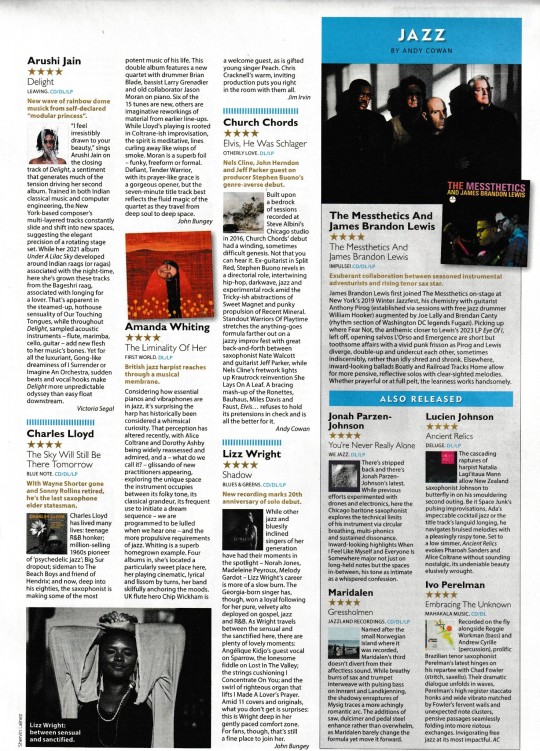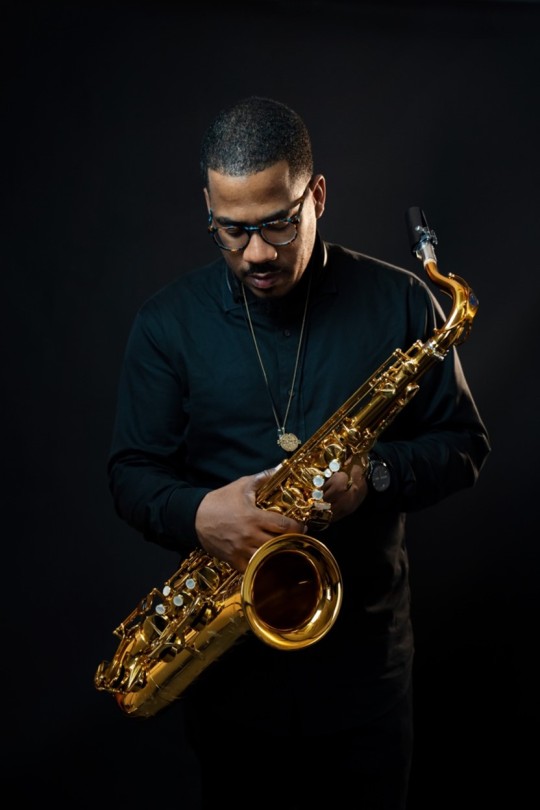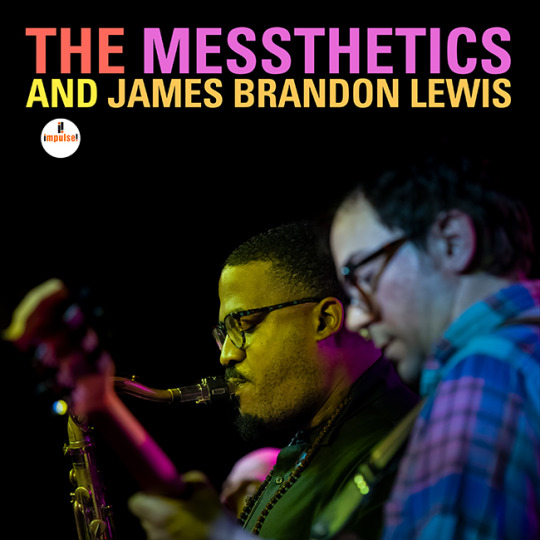#James Brandon Lewis
Text
03.20.24 Ches Smith's Laugh Ash with Shara Lunon voice and vocal processing, lyrics, Anna Webber flute, Oscar Noriega clarinets,James Brandon Lewis tenor sax, Nate Wooley trumpet, Jennifer Choi violin, Kyle Armbrust viola, Michael Nicolas cello, Shahzad Ismaily bass, Moog and Ches Smith electronics, drums, percussion. At Roulette Intermedium NYC.
#Ches Smith#Roulette Intermedium#Laugh Ash#Shara Lunon#Anna Webber#Oscar Noriega#James Brandon Lewis#Nate Wooley#Shahzad Ismaily#Jennifer Choi#Michael Nicolas#Kyle Armbrust
6 notes
·
View notes
Text

#mojo#mojo magazine#reviews#arushi jain#charles lloyd#amanda whiting#church chords#lizz wright#the messthetics#james brandon lewis#jonah parzen johnson#lucien johnson#maridalen#ivo perelman
2 notes
·
View notes
Text
Mendoza Hoff Revels - Echolocation - a blast of instrumental skronk rock
Ava Mendoza: electric guitar, compositions
Devin Hoff: electric bass, compositions
James Brandon Lewis: tenor saxophone
Ches Smith: drums
'Echolocation' is the astonishing debut album from Mendoza Hoff Revels, a formidable new unit led by Ava Mendoza & Devin Hoff and featuring James Brandon Lewis & Ches Smith.
While Mendoza and Hoff have floated around each other's musical orbits for decades, and have been friends for some time, this is their first work together on record. It is an electric & holy harmonic fusion of highly estimable musical forces; wholly rendered. The original impetus of this group was Mendoza’s, based on the love she and Hoff shared for aggressive and polyglot electric avant-garde ensembles – artists like mid-80's Black Flag (w/ Roessler & Stevenson) and Ornette Coleman's Prime Time bands revolutionized the way they heard music. As stated in their liner notes, "we shared the writing of these pieces, though without the sizable stamps of both James and Ches, they would sound nothing like they do here.”
The result – 21st Century progressive rock played by punk rockers with serious improv skills and a deep jazz feel. And vitally – non-stop wicked catchy tunes, riffs & grooves.
Strong sonic references on our initial hearing at AUM Fidelity were The Stooges’ Funhouse, rendered by an entire band readily adept at rapidly swinging rhythmic & harmonic shifts (plus tenor sax on every track!) -&- minutemen, both their entire body of music & their fundamental egalitarian punk ethos. A higher combo accolade to any "rock-adjacent" band playing with electricity we at AUM cannot bestow.
Art & Design by William Mazza Studio
#Mendoza Hoff Revels#Bandcamp#skronk#rock#jazz#fusion#punk#ava mendoza#james brandon lewis#ches smith#devin hoff#2023#aum fidelity
3 notes
·
View notes
Audio
Listen to: Sparrow by James Brandon Lewis / Red Lily Quintet
4 notes
·
View notes
Text
James Brandon Lewis/Red Lily Quartet — For Mahalia, with Love (Tao Forms)

Photo by Henri Selmer
For Mahalia, With Love by James Brandon Lewis / Red Lily Quintet
James Brandon Lewis reconvenes the Red Lily Quintet—with Kurt Knuffke on cornet, Chris Hoffman on cello, William Parker on bass, and Chad Taylor on drums—for a set inspired by songs associated with Mahalia Jackson, the towering figure in gospel music in the previous century. The group develops the brief melodies of these traditional devotional tunes into vehicles for improvisation and exploration, creating a joyful noise that celebrates Jackson and also recalls the exploration of themes associated with the Black church by Charles Mingus, Albert Ayler and Roland Kirk.
In some cases, such as “Swing Low” and “Wade in the Water,” the source material is readily apparent while in others it is less so. The set begins appropriately and gently with Lewis’s adaptation of one of Jackson’s signature songs, “His Eye Is on the Sparrow,” which provided the name for a radio show that she hosted in the 1950s and with which she wowed the 1958 Newport Jazz Festival. Lewis’s phrasing well captures Jackson’s meditation on a tune that, like the rest of those here, is beautiful in its simplicity rather than showy.
The quintet was rock-solid on its first outing, Jesup Wagon (2021), and is even more together this time around. Parker is, predictably, outstanding here, delving deep into the music whether soloing, as on “Go Down Moses” and the first minute of “Elijah Rock,” or providing bedrock support throughout. Hoffman’s cello often blends with Parker’s bass, somewhat like the dynamic between the two bassists in some of Coltrane’s bands. Knuffke once more serves as the perfect foil for Lewis as they alternately trade leads and blend their voices. His solo on “Deep River” well exemplifies his approach, building on the foundation established by Lewis before him, he ranges from flutters to searching cries consistent with the funereal theme of the song. Taylor, along with Parker, holds everything together, being equally effective in delivering frantic rolls, as on “Were You There,” and hand percussion, as on “Calvary,” and there are numerous satisfying moments when he and Parker lock in, such as the last couple minutes of “Elijah Rock”
Lewis’s ever-deepening mastery of the tenor is naturally on full display here. His playing, like this recording, delves into the history of jazz without ever sounding formulaic with a tone that is simultaneously ancient and cutting-edge. Here, his horn transforms into the voice of the great gospel singer, channeling as well the voices that she was influenced by and that influenced her.
Those who purchase the CD or vinyl versions can hear Lewis’s playing in a different context on a live recording of his composition for sax and strings with the Lutoslawski Quartet. Titled These Are Soulful Days, the piece interweaves themes from the spirituals and thus serves as a companion to the Red Lily Quartet recording. This fresh context for Lewis’s vision unfolds through the tranquil and plaintive “Prologue – Humility” and four movements to “Epilogue – Resilience.” The movements interweave more and less recognizable phrases from the gospel songs, particularly the dramatic eruption of “Wade in the Water” in Movement III, while “Epilogue” gets fairly noisy and atonal. An encore concludes the set in the form of a lyrical solo sax performance of “Take Me to the Water.”
For Mahalia, with Love, like Jesup Wagon and Lewis’s “Molecular” releases, is fairly high-concept, but the music is spunky and easy to enjoy, with plenty of groove and intensity. The bare nature of the source melodies is well-suited to jazz exploration (as successive generations of musicians have discovered). Lewis is still too young to be considered a jazz elder statesman (and national treasure), but he is steadily building a body of work and a perspective commensurate with that status.
Jim Marks
#james brandon lewis#red lily quartet#for mahalia with love#tao forms#jim marks#albumreview#dusted magazine#jazz#Kurt Knuffke#chad taylor#william parker#chris hoffman#mahalia jackson
2 notes
·
View notes
Text
JAMES BRANDON LEWIS: “EYE OF I”
È stato detto, quasi sempre in tono dispregiativo, che il jazz è un genere musicale per intellettuali, anzi per “intellettualoidi”. Antonio Gramsci in uno dei suoi più noti passi dei “Quaderni dal carcere”, scriveva che “tutti gli uomini sono intellettuali, ma non tutti svolgono la funzione di intellettuali”. Essendo io di stretta osservanza gramsciana, non posso che condividerne il pensiero. Se poi qualche dubbio in proposito vi resta e lo volete fugare al più presto, non dovrete far altro che acquistare “Eye of I” l’ultimo disco di James Brandon Lewis, uscito da qualche giorno per l’etichetta “ANTI-Records” e che vede, oltre che Brandon Lewis al sax tenore, Chris Hoffman al violoncello e Max Jaffe alla batteria e percussioni. Certo che chi avesse ancora nelle orecchie le storie dell’agronomo George Washington Carver, raccontato in “Jesup Wagon”, probabilmente penserebbe che si tratti del disco di un altro musicista, sia per sonorità che per tematiche, ma questo ribaltamento di obiettivi poetici e musicali, questa concezione diversa della musica, insomma questa versatilità multiforme, non sono segno di debolezza, ma anzi punto di forza di James Brandon Lewis. E non solo questo, poiché “Eye of I” è anche la dimostrazione teoretica che il jazz, non è affatto esclusivamente cibo per la mente contorta di eccentrici “intellettuali”, ma una prova di forza della musica stessa e delle capacità dell’uomo di crearla e veicolarla. Come si dice in certi casi questa era la doverosa premessa, prima di ascoltare il suono nudo e crudo di James Brandon Lewis, semplicemente ciclopico sassofonista che come il famoso “bacio come un rock” della canzonetta, ci tramortisce sul ring. “Selvaggio e spontaneo” lo definisce il comunicato stampa che accompagna l’uscita del disco, un lavoro che sposa decisamente le sonorità del free jazz e del groove, senza disdegnare l’intimità della ricerca, quasi monocorde, ispirata ad uno dei suoi più grandi e riconosciuti maestri, John Coltrane. Se si cominciasse l’ascolto da “The Blues Still Blossoms” questa eredità sarebbe ancora più evidente, con quel sax così solo e così pieno di senso che sembra lenire la banalità e prendersi cura della nostra anima. Spira invece tutt’altra aria nel primo brevissimo, ma programmatico brano, “Foreground“ con il sax che ancheggia e spara bordate vigorose ed energetiche. Se rimane tutto godibilmente groove in “Someday We’ll All be Free”, secondo brano del disco, preparatevi ad ingaggiare una battaglia nel quarto possente ed impietoso pezzo “Middle Ground”, con quella incredibile sventagliata di note da un sax che in 47 secondi inonda di energia pura mente e cuore. Non è da meno il brano che dà il titolo all’album, “Eye of I”, anche se giocato su toni più riflessivi e su una più complessa dialettica armonica e disarmonica, dovuta alle possenti percussioni di Max Jaffe. Nel disco i vuoti e i pieni si alternano ed ecco arrivare la rarefatta simmetria di “Within You Are Answers” e “Womb Water” (scritta in collaborazione con Cecil Taylor), la seconda più problematica con quel basso continuo del violoncello di Chris Hofman che la rende ancora più inquieta. L’attacco dolcemente elettronico della brevissima “Background” ci riporta in ambiente “free”. Questi pezzi brevissimi, come frammenti, sorta di meteoriti sonore, impreziosiscono e non poco la struttura dell’album. Di Free Jazz vive anche “Send Seraphic Being”, mentre “Even the Sparrow” simile a una colonna sonora circense, briosa e apparentemente disarticolata, offre una varietà mutevole di atmosfere, sempre sostenute dal sax di James Brandon Lewis. Infine ecco l’iniziale atmosfera notturna di “Fear Not” che si trasforma cammin facendo in una lunghissima cavalcata che raccoglie in sé sonorità persino un po’ pop-rock, in una costante tensione musicale di grandissimo livello, dove l’infinito assolo del sax di James si dispiega fino nell’eternità. Secondo The New York Times, Brandon Lewis è “un sassofonista che incarna e trascende la tradizione”, parole assolutamente condivisibili. Ottimo lavoro James!


3 notes
·
View notes
Text

#top 7 albums#weekly#lesser care#lightning bolt#the messthetics#james brandon lewis#aye nako#athletic automaton#pedro the lion#pinback
0 notes
Text
"L'Orso" by The Messthetics, James Brandon Lewis https://ift.tt/tv9Lu3r
0 notes
Text

The Messthetics and James Brandon Lewis
Photography: David Willingham
Client: Impulse! Records
0 notes
Text
Co w jazzie piszczy [sezon 2 odcinek 12]
premierowa emisja 27 marca 2024 – 18:00
Graliśmy:
Arve Henriksen, Harmen Fraanje “Touch Of Time” z albumu “Touch Of Time” – ECM Records
Vijay Iyer and Linda May Han Oh, Tyshawn Sorey “Nonaah” z albumu “Compassion” – ECM Records
The Messthetics and James Brandon Lewis “Emergence” z albumu “The Messthetics And James Brandon Lewis” – Impulse! Records
Matthieu Bordenave “Cyrus” z albumu “The…

View On WordPress
#Andrea Sabatino#Arve Henriksen#Blue Note Records#Circles 44#Co w jazzie piszczy#Dave Harrington#Dodicilune#ECM#Ethan Iverson#Harmen Fraanje#Hlava XXII#Impulse! Recrods#James Brandon Lewis#John Surman#Jonah Parzen-Johnson#Linda May Han Oh#Matthieu Bordenave#Max Jaffe#Mirka Abelova#NaraBara#Okvsho#Patrick Shiroishi#Ra Kalam Bob Moses#Roberto Ottaviano#Samo Salamon#The Messthetics#Treen#Tyshawn Sorey#Vasil Hadžimanov#Vijay Iyer
0 notes
Text
youtube
James Brandon Lewis’ Red lily quintet Fallen flowers Live
1 note
·
View note
Text
youtube
The Messthetics, James Brandon Lewis - Emergence - their forthcoming album promises to be a real skronkfest :)
1 note
·
View note
Audio
Listen to: Swing Low by James Brandon Lewis / Red Lily Quintet
2 notes
·
View notes
Text
Brent Cordero & Peter Kerlin — A Sublime Madness (Astral Spirits)

A Sublime Madness by Brent Cordero & Peter Kerlin
The partnership of Brent Cordero and Peter Kerlin precedes the pandemic, but the 2020 shutdown set the stage for them to make something lasting out of it. At any rate, it cleared their schedules. Furthermore, the tenor of the times created a milieu that the album acknowledges and responds to.
Cordero, who has played keyboards for Psychic Ills and Mike Wexler, provides organ, piano and synthesizer. Kerlin, of Sunwatchers and the Solar Motel Band, plays upright and electric basses. They first recorded as an improvising duo on Kerlin’s album Glaring Omission, which documents his efforts to come to terms with the eight-string bass. But, with time on their hands and the state of the nation on their minds, they set about organizing their music into a cohesive statement. While improvisation still figures in their methods and sonic orientation, the album was assembled in stages, with guest players adding drums, horns, viola and synthesizer to the duo’s original recordings. In essence, the solos function to provide focus and emotional impact to music that takes note of examples that are jazz-adjacent, but not jazz-confined.
“Movement To Protect The People” opens with a churchy organ melody. It sets the stage for an intricate countermelody articulated by an upright bass, which is then overtaken by spare piano notes, which drift in time with Ryan Sawyer’s stately, swinging backbeat. With each change, I found myself waiting for a voice that never arrives — Robert Wyatt’s. The tunes, textures and vibe all sound deeply inspired by his work, and the title suggests that their hearts beat in time with that of music’s most compassionate communist. However, the title of the propulsive waltz that follows, “Decolonize This Place,” articulates a consciousness that is very tuned into the trials of the present; Kerlin and Cordero aren’t just playing out their Soft Machine dreams. And the music is equally tuned into newer information. The effects on Cordero’s organ during the first solo show an engagement with malleable, distorted sound shaped more by pedal-hopping guitarists than post-bebop keyboardists. And a rippling performance by tenor saxophonist James Brandon Lewis adds to Kerlin and Cordero’s virtual community.
Over the next five tracks a steady stream of musicians, including Jessica Pavone, Ryan Jewell and Daniel Carter, add their distinguishing voices to music that sounds like it is trying to transcend the realities alluded to by titles such as “White Supremacy In Black Face” and “Affordable For Who?” You can’t change the facts on the ground by slapping stirring names on instrumental compositions. But in a time when the American political discourse has morphed into a naked donnybrook over the means by which dissenting voices will be told how to shut up, it feels as necessary to say where one stands as it does to give comfort to those who are standing up.
Bill Meyer
#brent cordero#peter kerlin#a sublime madness#astral spirits#bill meyer#albumreview#dusted magazine#james brandon lewis#daniel carter#jessica pavone#ryan sawyer#soft machine
5 notes
·
View notes
Text
youtube
James Brandon Lewis
1 note
·
View note